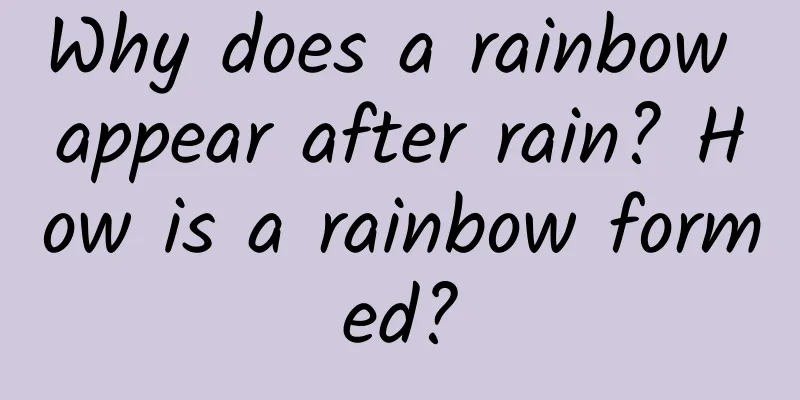Why does a rainbow appear after rain? How is a rainbow formed?

|
A rainbow is a complete circle, with the center being the midpoint of the perpendicular line between the sun and the earth. Usually, we feel lucky when we see a rainbow. Sometimes, after the rain, we can see a long rainbow of seven colors hanging in the sky. It is very beautiful, like a bridge. So how is a rainbow formed? Let's discuss it together. Contents of this article 1. Why does a rainbow appear after rain? 2. How is a rainbow formed? 3. How many colors does a rainbow consist of? 1Why does a rainbow appear after rain?The sunlight directly hits the water droplets in the air, which refract and reflect to form a rainbow in the sky. The light is incident at different angles, and the water droplets reflect at different angles, arranging to form a colorful spectrum. The brightness and size of the rainbow depends on the size of the water droplets. The larger the water droplets, the more obvious the rainbow. The reflection is strongest at an angle of 40° to 42°, and rainbows are most likely to form. A rainbow is a complete circle, with the center being the midpoint of the perpendicular line between the sun and the earth. Sometimes, another rainbow with the colors in the opposite order appears above the rainbow, which is called a rainbow. 2How are rainbows formed?A rainbow is formed when sunlight shines on small, nearly spherical water droplets in the air, causing dispersion and reflection. When it rains or there are water droplets, sunlight will pass through the water droplets from different angles and will be reflected at different angles in the water droplets. When it is reflected at 40-42 degrees in the water droplets, a rainbow will be formed. Sometimes you can see a long rainbow in the sky after the rain, which is very beautiful, just like a bridge. However, the rainbow is not always seen after the rain, and the reason why the rainbow appears is mainly due to the principle of refraction and reflection of light. A rainbow is formed when sunlight shines on small, nearly spherical water droplets in the air, causing dispersion and reflection. When sunlight passes through the water droplets, it enters from different angles and is reflected at different angles inside the water droplets. When it is reflected at 40-42 degrees inside the water droplets, a rainbow is formed. In detail, when sunlight enters a water droplet, it is first refracted, then reflected on the back of the water droplet, and refracted again when it leaves the water droplet. That is to say, only after two reflections and refractions can a rainbow be formed. Rainbows often appear in the afternoon or after rain. From the outer circle to the inner circle, there are seven colors: red, orange, yellow, green, cyan, blue, and purple. 3How many colors does a rainbow consist of?A rainbow, also known as a sky rainbow or simply a rainbow, is an optical phenomenon in meteorology. When sunlight hits water droplets in the air, the light is refracted and reflected, forming an arched colorful spectrum in the sky. It is common after rain. The shape is curved, usually semicircular. The colors are bright. The most common description of the seven colors of light in East Asia and China is in descending order of wavelength: red, orange, yellow, green, blue, indigo, and violet. |
<<: What are the ingredients of loquat? How to clean loquat
Recommend
The woman smells fishy
If a woman has a fishy smell on her body, she sho...
How to treat menopausal depression? Please remember these reliable methods
Many women will experience depression during meno...
Special Edition of COVID-19: How to Correctly Change Wound Dressings at Home
This is the 3771th article of Da Yi Xiao Hu Durin...
What is mild atypical hyperplasia of the cervix?
You must have heard of cervical cancer! So, do yo...
“Health from Food” Series | Can you eat “pure natural food” with confidence?
Many people are worried that adding preservatives...
The number of antral follicles in normal women
Normally, no one pays attention to the antral ovu...
How old can girls grow taller?
Being tall and having long legs is a figure that ...
Can I eat pineapple while breastfeeding?
Pineapple is a very common fruit in our lives and...
Demystifying brain injury recovery: Why timing, method and persistence are equally important?
Author: Zhang Hao, Chief Physician, China Rehabil...
Are succulents afraid of frost? What should I do if succulents are exposed to frost?
Succulents are a common plant in life. They are d...
What is the chance of pregnancy during the dangerous period?
The dangerous period of pregnancy can also be sai...
What is the difference between honey tangerine and sugar tangerine? What happens if you eat too much sugar tangerine?
As the name suggests, the tangerine peel is not s...
Do boys like girls with chubby bodies? Why are chubby girls more popular with boys?
We all know that most girls are thin and slender,...
What kind of scented tea can make your breasts bigger? Here are some recommended ones
Women all hope that their breasts can be fuller s...









